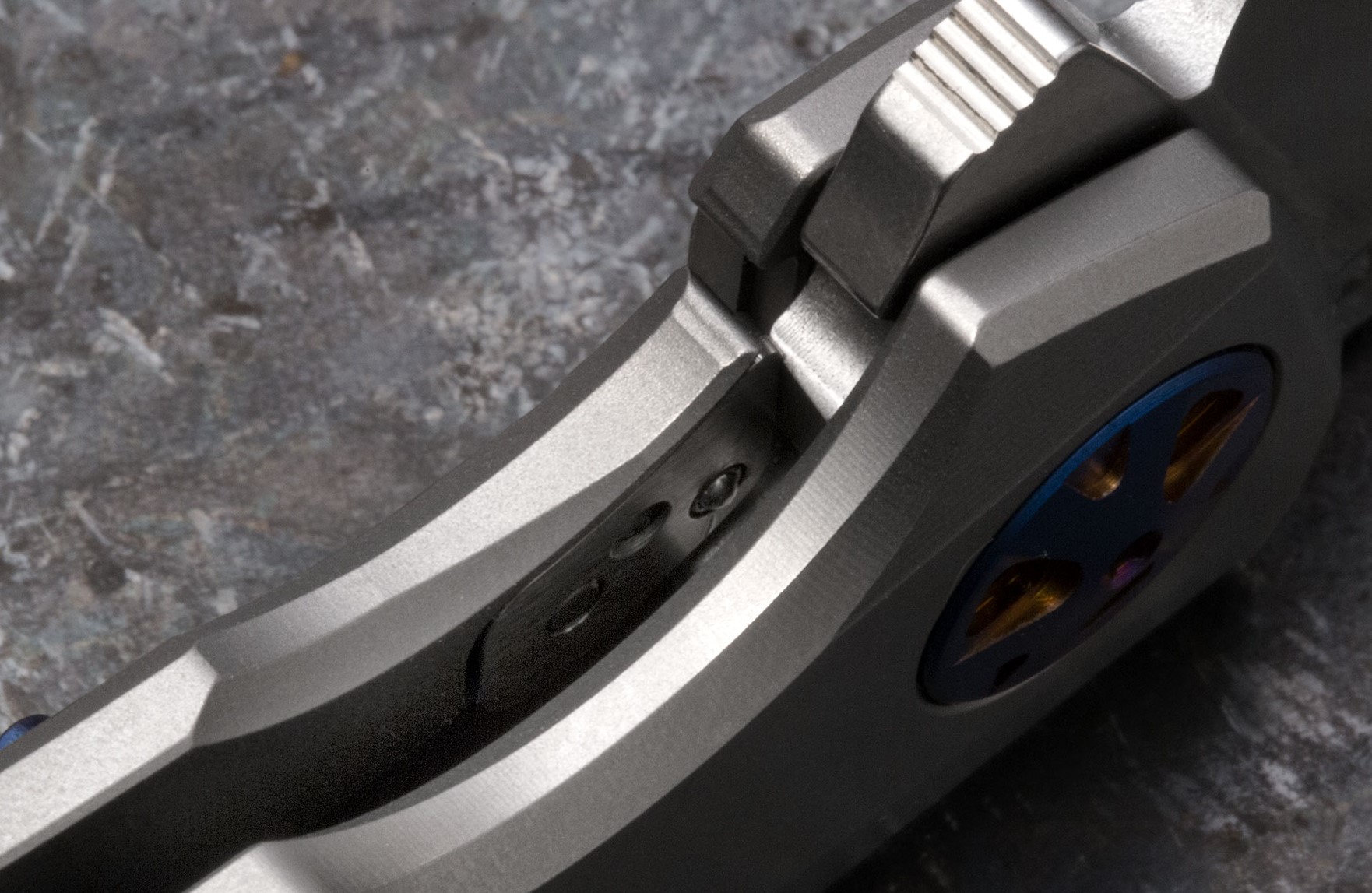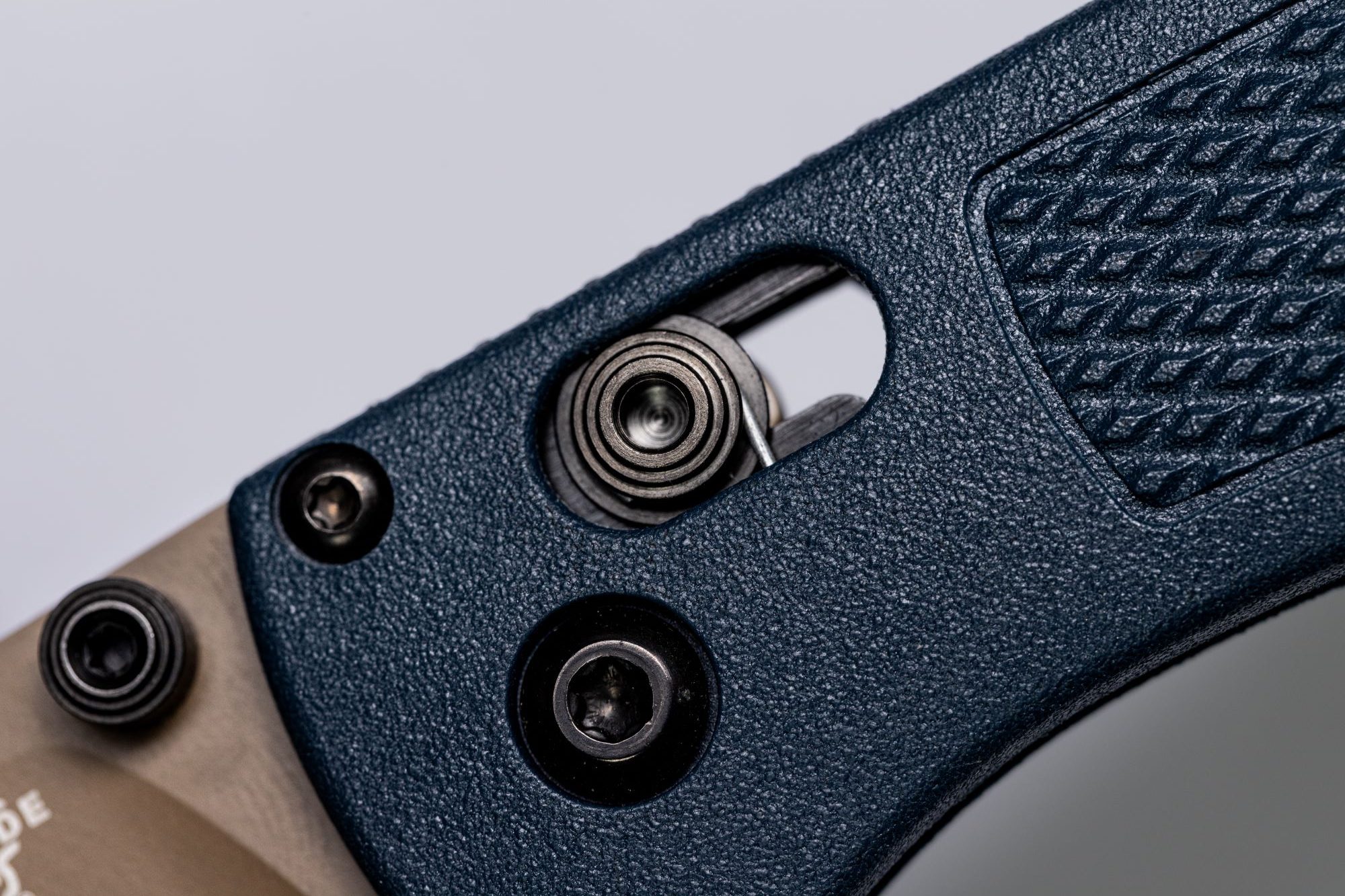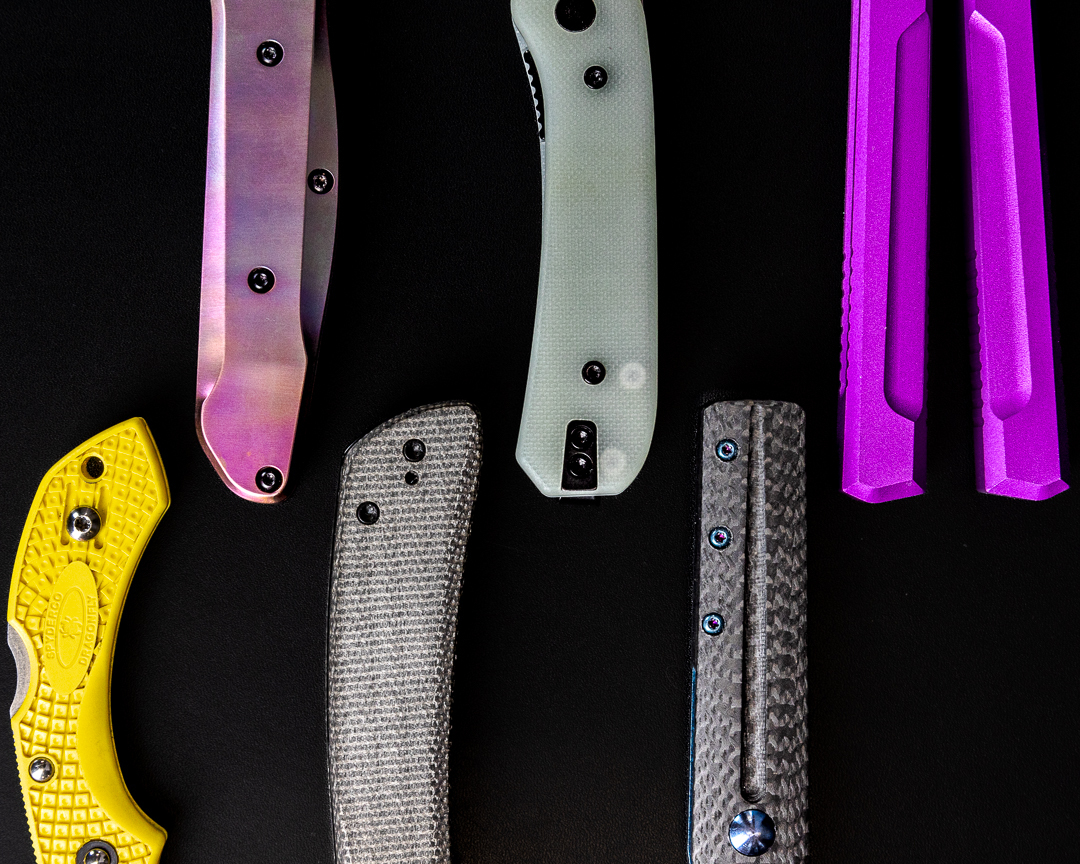With all the different types of knives today, it can be easy to get lost in the seemingly endless information. Lucky for you, this knife type guide will walk you through the basics!
The five basic types of knives are:
- Manual Folding Knives – Blade folds inside the handle with no assisted mechanism.
- Spring Assisted Knives – Blade is assisted open with a spring or bar.
- Automatic Knives or Switchblades – Blade automatically opens with the push of a button or pull of a lever. The two styles are Out The Front (OTF) and side opening.
- Fixed Blade Knives – Blade is fixed to the handle and does not pivot.
- Butterfly or Balisong Knives – Two handles rotate around a blade.
- Knife Styles that Fit Multiple Types
Now, let’s dive into the different types of pocket knives:
MANUAL FOLDING KNIVES

Manual folding knives have a blade that folds inside the handle, covering the cutting edge. Many of these types of knives have a locking mechanism that keeps the blade in the open position. All manual knives feature a mechanism to keep the blade closed and safe in your pocket.

This picture shows the detent ball that is used to keep a blade in the closed position. It is the most common type of “stay closed” mechanism and works by the detent ball moving along the blade as it closes. The detent ball then settles in a small hole in the blade when it is fully closed.
Pros of Folding Knives
- Compact/convenient
- Very dependable
- Protected cutting edge
- Legal in many places
Cons of Folding Knives
- Moving parts can get grimy/sandy/peanut-buttery
- More moving parts = higher probability to fail
- Smaller blades with less real estate
- Pivot requires more maintenance
Folding Knife Uses
Yep, you guessed it. Most people use a type of folding knife for everyday carry (EDC). Common uses include everyday tasks like opening boxes containing newly acquired knives from Blade HQ, showing off to friends, or cutting into their favorite cheese wheel (we prefer Pepper Jack). They’re just plain handy to have around.
SPRING ASSISTED KNIVES

Spring assisted knives are a type of folding knife that flips open with a little assistance from the user. These knives have a spring or bar inside that puts tension on the blade, so when the user opens the blade to about 30 degrees, the blade then flips the rest of the way open. They often open with a flipper or thumb stud.
Pros of Spring Assisted Knives
- Not considered switchblades or autos
- Laws generally coincide with manual folding knives
- Easy one handed opening
- Open faster than manual knives
Cons of Spring Assisted Knives
- More moving parts that can wear out/break
- Pivot requires more maintenance
- Possibility of opening in a pocket (extremely rare)
Spring Assisted Uses
Spring assisted knives came on the scene as a knife that opens faster than a manual, but would circumvent the strict Federal Switchblade Act of 1958 that governs push-button automatic knives. Because spring assisted knives open with a flipper or thumb stud, they typically are not considered automatic knives or switchblades in many legal jurisdictions. Many people use assisted opening knives like they would manual opening knives, but they fidget with them more. There’s something sweet and satisfying about that blade flipping open on a spring assisted–the sound, the lockup, the quick action– it’s dreamy.
AUTOMATIC KNIVES OR SWITCHBLADES
Automatic knives, or switchblades, have blades that flip open with the push of a button. There are also variations that open via a lever or switch on the handle. The two basic styles of automatic knives are side opening and Out The Front (OTF).
Side Opening

Side opening automatics have a blade that comes out of the side of the handle when a firing button is pressed. This snappy action makes the blade accessible quickly.
Side Opening Uses
Side opening automatic knives are designed primarily for the military and first responders like police and firefighters. What do all these have in common, you ask? Emergency situations happen all the time and when someone is trapped in a sinking vehicle, seconds count. Automatic knives are designed to open speedy fast for people with speedy needs.
Because of their rich history in Hollywood’s portrayal of urban street violence in the 1950’s, automatic knives face many harsh restrictions around the US. Consult your local laws before purchasing an automatic knife.
OTF KNIVES

OTF, or Out the Front, knives have a blade that exits out the front of the knife. We know: hard to believe from the name. OTF knives are a style of automatic knife because they use a button to activate a spring to automatically open the blade.
Two types of OTF knives:
- Single Action – Extend with the push of a button or slide, but then require a manual retraction.
- Double Action – Extend with the push of a button or slide, and then retract with the same type of function.
OTF Uses
OTF knives are great for lighter use and normal EDC. OTF blades come in different shapes, but many people are drawn to the dagger blade style (blades that are sharp on both sides).
Just remember, because OTF knives and switchblades are often misunderstood, it’s important to consult your local laws before purchasing one of your own.
| Side Opening | OTF | |
| Pros |
|
|
| Cons |
|
|
FIXED BLADE KNIVES

Fixed blade knives are just that; the blades on these knives are attached to the handle and cannot be folded.
Popular types of fixed blade knives:
Fixed blade knives vary in size, shape, and materials, which is why there are so many uses for different types of these knives.
Pros of Fixed Blade Knives
- Easy maintenance
- High strength
- Many variations
Cons of Fixed Blade Knives
- Harder to conceal and carry
- Have to use with a sheath
Fixed Blade Uses
There is truly a fixed blade knife for every situation. Smaller neck knives can be great for concealment. Machetes are great for cutting large plants and trees. Many fixed blades also make great hunting knives. Bottom line: you can find a fixed blade for whatever you’re up to. Just make sure you’re not up to no good.
BUTTERFLY/BALISONG KNIVES

Butterfly knives, or balisong knives, have two handles that pivot around a blade. These knives are very popular for flipping and recreational use.
Pros of Butterfly Knives
- Fun to flip
- Can be used as a functional knife
Cons of Butterfly Knives
- Not as practical as other knives
- Many law restrictions across the country
Butterfly Knife Uses
Although butterfly knives can be used like other knives, their main use is for recreational flipping:
Don’t worry, if you want to get into flipping without losing a finger, that’s where butterfly knife trainers come in. These trainers have dull blades that won’t cut anything and are perfect for beginning flippers.
KNIFE STYLES THAT FIT MULTIPLE TYPES
Let’s preface this section by saying it’s going to get a little confusing, and that’s okay. We’ve gone over knife types, which are the manual, spring assisted, automatic, fixed, and butterfly. Now we’ll go more into knife styles.
A style of knife is like a category, such as hunting knives, OTF, throwing knives, etc. Some styles are made as multiple types, which leads us to this section. Let’s dig in, shall we?
- Karambits are the ultimate self-defense tool. They are available in fixed blades, folding, and even butterfly knives.
- Neck knives are usually compact knives that come in fixed blade and manual folding.
- Hunting knives come in fixed blade, manual, and automatic, and are made to cater to a hunter’s needs. Most of these knives are fixed blade and have a mild curve, fit into a sheath, and are made to be sturdy. Specialty types like skinning knives are made for skinning animals.
- Fishing knives come in fixed blade and manual folding, and are made for everything from cutting a line to prepping a fish for a nice feast.
- Bowie knives are a style of knife that usually has a double edge at the point of the blade. They are a very popular style and come in every type of knife.
- Multi-tools usually contain several blades along with other tools, such as pliers. A common example of a multi-tool is a Leatherman.
- Dive knives are made specifically for scuba divers and usually contain materials that will not rust. They come
in fixed blade and manual, and cater to every situation a diver may face. - Fillet knives can be fixed blade or manual, and have long, skinny, flexible blades that are used to fillet fish.
- Throwing knives, axes and stars are designed for the sport of throwing. Many people use these recreationally, but just know that professional knife throwing is a thing.



